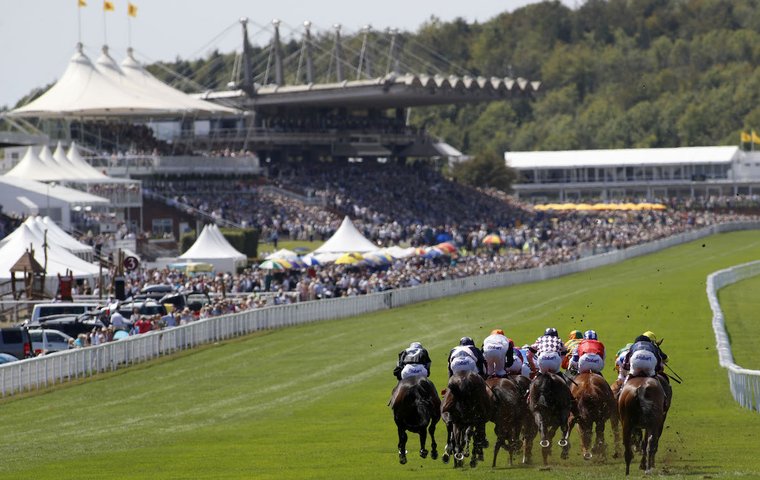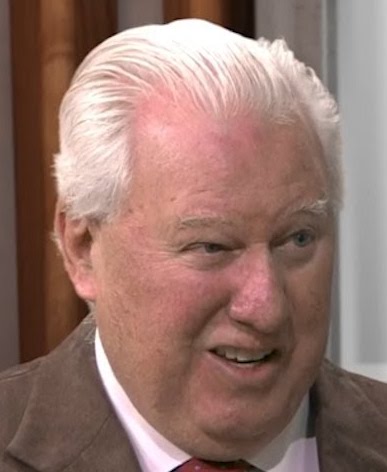
Five days of high-class racing in the beautiful English countryside is highlighted the third meeting of star three-year-old milers Rosallion and Notable Speech in the £1 million Qatar Sussex Stakes
 Glorious Goodwood. The clue is in the name.
Glorious Goodwood. The clue is in the name.
Late July, early August, on the magnificent rolling Sussex Downs, in a belt of the most beautiful countryside in Britain.
Where horses of the highest quality contest a variety of races at distances from five furlongs to 2½ miles on arguably the most idiosyncratic track in Europe. What more could any racing fan ask for?
Well, for starters, the weather. You need the ‘Glorious’ to materialise for this five-day race meeting to be a success. When the sun shines, the Goodwood estate is out on its own. There is no other racecourse like it. But if the weather gods turn nasty, it makes for an unpleasant experience so miserable that many are counting the minutes before they dash to their cars and take to the winding roads and highways out of the place.
Simon Holt, an enduring voice in the commentary box in this part of the world, recalls when the Roger Charlton-trained Genki won the 2009 Stewards’ Cup. This is the traditional six-furlong sprint handicap, which starts out of view of the grandstand – and this time a shroud of thick fog enveloped the course, making it impossible to identify any of the 26 runners in the first half of the race.
In desperation, attempting to fill the dead air, Holt announced to the crowd: “If you see them before I do, give us a shout!”
The laughter on the steppings eased the tension. There is something haunting, almost spooky, waiting for the ghostly figures to appear from the mists and the gloom. “I was never so terrified calling a race as I was that day,” Holt recalls.
The weather gurus reckon we can all sleep easily – racecallers included – safe in the knowledge that generally fine weather with cloudy intervals is forecast for Qatar Goodwood Festival week, commencing on Tuesday [July 30]. Which should be conducive to a variety of excellent races, headed by the G1 Sussex Stakes, first run in 1841 and won by such greats as Brigadier Gerard (1971), Giant’s Causeway (2000) and Frankel (2011, 2012).
Pardon the clichés, but this year we are heading for the Duel On The Downs III. In the modern era, there was Frankel v Canford Cliffs (2011) – a mismatch in retrospect but a talking point that season – followed by Toronado v Dawn Approach (2013), which drew together two outstanding milers of that Classic generation.
Duel On The Downs III is something similar in that the unique 2,000 Guineas winner Notable Speech is set for a third clash with Rosallion, whom he defeated at Newmarket but who then impressively reversed the form in the St James’s Palace Stakes at Royal Ascot. The trainers of these two cracking colts are both, by nature, up for the fight.
Rosallion, by champion sprinter Blue Point out of the New Approach mare Rosaline, has the Godolphin imprint but was bred by his owner Sheikh Mohammed Obaid Al Maktoum, whose yellow-and-black spotted colours have enjoyed enormous success globally in the past 12 months, also notably with Without A Fight in the Melbourne Cup, as well as sprinter Inisherin.
Richard Hannon, Rosallion’s trainer, knows first hand what a Duel On The Downs entails. He was assistant to his father, Richard senior, when Canford Cliffs was steam-rollered by Frankel to the tune of five lengths, and also when Toronado took his revenge on Dawn Approach – and he had taken over the licence by the time Toronado gave best to Kingman in 2014.
Looking back, Hannon identifies certain features that tally with what can be expected this week. “With Canford Cliffs, we were hopeful,” he says, with reason – after all, the colt had won five races on the trot, including beating the great Breeders’ Cup heroine Goldikova at Royal Ascot.
“I really didn’t think there was a horse who could do that to Canford Cliffs, but Frankel did,” he goes on. “He beat him by five lengths.
“But with Toronado, he beat the horse [Dawn Approach], who had beaten him in the St James’s Palace, and there are similarities with Rosallion and Notable Speech. They both go to Goodwood with big reputations. Our horse won the St James’s Palace and Notable Speech beat him into second in the Guineas.
“I’m not sure there’s a Frankel in the race this year, but we have basically the same horses meeting so it’s fascinating. The only thing that worries me is the track side. But if the same horse turns up [Rosallion] as at Ascot, then we’ve got an excellent chance. Physically and mentally, our colt is great.
“He’s very special for me and everyone in the place. It’s very exciting to have one like him and we are looking forward to the race. If you are not looking forward to it, you shouldn’t be running.”
Cheekily, I suggest maybe such ‘scaredy cats’ shouldn’t even be in racing? “Probably not,” he smiles.
Charlie Appleby is of like mind. Notable Speech, the colt he trains for Godolphin, is unique in that he won the 2,000 Guineas on the back of three wins on the all-weather track at Kempton, having never raced on turf. He displayed a dazzling turn of foot on the Rowley Mile to beat Rosallion and Haatem, who have since franked the form with certain authority.
“Bring it on,” says Appleby. “I’m quite enjoying the build-up. Rosallion is the horse to beat, obviously, and he’s getting the headlines. We are sailing under the radar, which is nice. Some are asking why I think Notable Speech can beat Rosallion, and I reply ‘well, he has beaten him once!’”
Notable Speech was 4-4 going to Royal Ascot, yet he finished a disappointing seventh of eight (six lengths behind Rosallion), sent off 6-4 favourite in the St James’s Palace Stakes. So what went wrong with the son of Dubawi? Clearly, something was not right.
“Hand on heart, I can’t put my finger on what it was,” Appleby admits. “I can throw half-a-dozen suggestions into the box and people can make of them what they like. The fact is he came back sound. His bloods were good. His scope was good. He was six kilos heavier going into Ascot than he was before the Guineas.
“But he’s a three-year-old and he’s entitled to get stronger. Anyway, six kilos is nothing. Before Newmarket, he was hard fit for his runs on the all-weather and a racecourse gallop, while he then had a little break after the race. It’s still difficult to work out.”
Nevertheless, Appleby is cautiously optimistic about the Sussex. “I’m so much happier the way the horse is now than I was going to Ascot,” he says. “He gets turned out all day, he comes in, he grubs up [eats] … and he looks fantastic. I think many will be impressed how well he looks.”
Ballydoyle’s colt Henry Longfellow, who was runner-up in the St James’s Palace, makes up the trio of three-year-olds who dominate this classy all-aged test on the sharp, right-handed track with unusual contours, which often makes for traffic problems in races with capacity field sizes.
Over the five days, there are numerous other highlights in prospect. Apart from the Duel III, the return to the Downs of the grand stayer Kyprios in Tuesday’s G1 Goodwood Cup is a feature many consider unmissable.
Winner of 11 of his 15 starts, his appearance will revive memories of his stirring defeat of Stradivarius in the 2022. He comes to this year’s race having won all three of his races this year, including the Ascot Gold Cup.
Indepedent tracks join forces to lure internationals
A triumvirate of key officials at Ascot, Goodwood and York are hell-bent on attracting international runners to their showcase summer meetings in the face of fierce competition from a variety of countries, including Saudi Arabia, Dubai, Bahrain and Qatar.
Ascot’s Nick Smith has previously aired his concerns at the ‘headwinds’ hitting the sport in Britain, with smaller prize-money in comparison to the Middle East cited as a major issue.
 As a result, Ascot have strengthened their global recruitment drive that is ongoing, while Goodwood’s director of racing Ed Arkell and his counterpart William Derby at York are equally determined to package their major meetings to attract overseas commitment.
As a result, Ascot have strengthened their global recruitment drive that is ongoing, while Goodwood’s director of racing Ed Arkell and his counterpart William Derby at York are equally determined to package their major meetings to attract overseas commitment.
Derby says the three racecourses have been engaged in “a huge amount of discussion that’s been going on for a long time now – and the tracks work collaboratively together.” Arkell adds: “The three big races in the middle of summer – Goodwood’s Sussex Stakes, the King George VI and Queen Elizabeth Stakes at Ascot, and the Juddmonte International at York – are probably where we need to focus our attention. They offer the biggest opportunity to attract runners internationally.
“All three of us, Goodwood, Ascot, York, have our own individual sponsors, relationships and deals and trying to create one thing [a blanket sponsorship] would be difficult.
“But the three big races are over the right distances to attract international horses and if we can promote those, you would hope trainers might look at them and think there is a nice gap in the summer that could be used to bring their horses to Britain and run in those good races.
“No horse is likely to run in all three of those big races, and I would be very careful about calling it a Triple Crown, which refers specifically to three Classic races (for three-year-olds). But if we can promote those races when the rest of the international stage is quiet, then maybe we could attract the Japanese, the Australians and Americans.”
Derby emphasises the importance of the international element. “It is vital for us at York in terms of trying to get the best talent to York,” he says.
“It’s important for our customers, both on course as well as those watching and betting on the sport. It’s been a long-term trajectory and vision of the York Race Committee (YRC) and that’s why we invest so much money in our race program and our racing surface to try to get the best racing we can to York.
“Our showcase Ebor meeting takes place at a great time of the year for European horses and those from other jurisdictions to meet before the marvellous targets in Australia, Hong Kong, America and France come up. It’s a great time of the season.
“It’s what we at York are about as effectively a non-profit club – investing in the best facilities, the best racing that we can. We at York have a long record of getting internationals – Zenno Rob Roy for the International in 2005, Ortensia in 2012 – so it’s been a long-term strategy.
“But what we don’t have in Europe and the UK is unlimited resources. We are not in the economic situation where we can match the prize-money of those mid-winter/spring targets in the Middle East but what we do have are great carnivals and great racing.
“A unique advantage that I think we have at York is we are flat and left-handed,” he goes on. “We are a mini-Tokyo, mini-Flemington layout. So that’s helpful for horsemen to understand. We are working hard at making our races as valuable as they can be and the welcome as big as it can be.”
York’s Juddmonte International [Aug 21] is due to be the richest race ever run on Knavesmire, with total prize-money of £1.25 million representing a 25% rise on last year. Derby winner City Of Troy is on schedule to contest the G1 feature.
• Visit the Qatar Goodwood Festival website
View the latest TRC Global Rankings for horses / jockeys / trainers / sires


